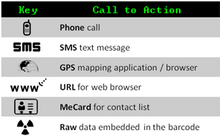
A SPARQCode is a matrix code (or two-dimensional bar code) encoding standard that is based on the physical QR Code definition created by Japanese corporation Denso-Wave.
Overview
The QR Code standard as defined by Denso-Wave in ISO/IEC 18004 covers the physical encoding method of a binary data stream. However, the Denso-Wave standard lacks an encoding standard for interpreting the data stream on the application layer for decoding URLs, phone numbers, and all other data types. NTT Docomo has established de facto standards for encoding some data types such as URLs, and contact information in Japan, but not all applications in other countries adhere to this convention as listed by the open-source project "zxing" for QR Code data types.
Encoding standards

The SPARQCode encoding standard specifies a convention for the following encoding data types.
- E-mail address
- Phone Number
- SMS TEXT
- MAP
- URL
- BIZCARD
- MeCard
- vCard
- BlackBerry PIN
- Geographic information
- Google Play link
- Wifi Network config for Android
- YouTube URI
- iCalendar
The SPARQCode convention also recommends but does not require the inclusion of visual pictograms to denote the type of encoded data.
License
The use of the SPARQCode is free of any license. The term SPARQCode itself is a trademark of MSKYNET, but has chosen to open it to be royalty-free.
References
- "QR Code Standardization | QR Code.com". Denso-wave.com. Retrieved 2010-02-25.
- "Barcode Contents". zxing – A rough guide to standard encoding of information in barcodes. Retrieved 25 February 2010.
- "Barcode Contents". zxing Wiki. Retrieved 27 March 2016.
- "SPARQCode Trademark - Terms Of Use". mskynet.com. Retrieved 25 February 2010.
| Barcodes | ||||||
|---|---|---|---|---|---|---|
| Linear barcodes |
| |||||
| Post office barcodes | ||||||
| 2D barcodes (stacked) | ||||||
| 2D barcodes (matrix) | ||||||
| Polar coordinate barcodes | ||||||
| Other | ||||||
| Technological issues | ||||||
| Other data tags | ||||||
| Related topics | ||||||

